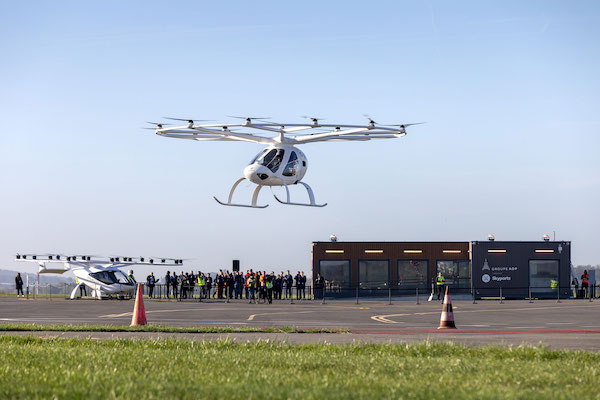
Alongside the tarmac at the Pontoise Aerodrome on the outskirts of Paris stands a sleekly modern building the size of a coffee shop with floor-to-ceiling windows. This is the Re.Invent Air Mobility test bed: Europe’s first flying-taxi airport, or vertiport. To mark its inauguration in November, a shiny white electric vertical takeoff and landing (eVTOL) aircraft with an armature of 18 whizzing rotors lifted up, flew around under the guidance of its test pilot and then touched down again. With a little luck, a network of sites like this will anchor the world’s first commercial flying-taxi service, shuttling passengers between Paris’s international airports and the venues of the 2024 Summer Olympic Games.
Or maybe a lot of luck. The Volocopter Volocity 2X flown at the ceremony in November is certified to fly only on an experimental basis. The entire vertiport plan relies on the aircraft achieving full certification, which would make it the first eVTOL to be certified to carry passengers anywhere in the world. “It’s on the ambitious side of what is possible,” says Duncan Walker, co-founder and chief executive officer of Skyports, the UK-based company that’s developing the project with Groupe ADP, the operator of Paris’s international airports.
Building infrastructure for a form of transportation that’s still largely hypothetical is a leap of faith, but probably a necessary one. After all, any air taxi system is going to need not only vehicles but also places where passengers can get in and out of them. “There are a lot of pieces that need to come together,” says aerospace consultant Sergio Cecutta. “It’s like baking a cake. If you mix up the ingredients the wrong way, the cake doesn’t come out very well.”
If the Paris plan succeeds, it will be a coming-of-age moment for a technology that—though it’s attracted $13 billion in investment since 2010—has consistently fallen behind its most optimistic backers’ timelines. It calls for a fleet of 10 Volocity aircraft to shuttle passengers along two routes: between Paris’s two international airports and the Quai d’Austerlitz in the central city, and between the Issy-les-Moulineaux heliport in town and the Saint-Cyr l’École airfield near Versailles.
The idea is to use the Paris Olympics to pave the way for a permanent regional network, which a Groupe ADP spokesperson says should be fully operational “towards the end of the decade.” Volocopter, based in southern Germany, is also working with partners to start service in Rome and Singapore in 2024 and Japan and Saudi Arabia the following year.
All these plans hinge on successfully introducing a working air taxi into service. Would-be manufacturers have been touting the imminent debut of their vehicles for years, but certification—or even demonstrating the ability to carry passengers from point A to point B—has remained elusive. Certifying any aircraft is a long and expensive process, and eVTOLs face a tougher challenge given their novelty and the way they push the limits of what is feasible using current engineering techniques.
Still, Volocopter is near the head of the pack of hundreds of aspiring eVTOL companies. Flying manned demonstrations since 2011, it’s logged more that 1,500 flights. The design concept is essentially a scaled-up quadcopter. It’s slower and smaller than some competitors, but it’s also mechanically simpler, an advantage when it comes to certification and maintenance.
To be sure, the concept has its limitations. The Volocity 2X has just two seats, one for a pilot and one for a customer. Given that the aircraft are expected to make two to three flights per hour, and that each carries a single passenger, the system at the Paris Olympics would have a total daily capacity of no more than a few hundred passengers a day. The economics are essentially impossible, concedes Volocopter CEO Dirk Hoke. “No one can deny that,” he says. “The advantage is, we will gain experience in operation while no one else is flying. We will be alone in the market.” With typical startup optimism, Volocopter plans to develop autonomous flying capabilities, better batteries and other technology that will help it carry more passengers in each vehicle, a shift that could radically improve its financial prospects.
Even with an improved pilot-to-passenger ratio, no one really knows if it will prove possible to run eVTOL services profitably. Among the major outstanding questions are what real-world operating costs will be, how much noise the machines will make and how much passengers will be willing to pay. Then, of course, there’s the question of whether and where eVTOL aircraft will be allowed to fly. The test bed project at Pontoise aims to answer some of these questions, but the full picture will only emerge as commercial service gets underway. That means not only getting permission to start service during the Olympics, but also a go-ahead to stick around afterward. “It would be a failure for everybody,” Walker says, “if there were flights at the Olympics, it got a lot of press, and then six weeks later there was no service.”
This article originally ran in Businessweek on April 4, 2023.
I have been following you on television and the science programs you have had a part in but the most fascinating thing is how much you look like an old friend of mine from Houston, Texas – William ‘Bill’ Z. Wise. He would be in his mid to late seventies now. Thank you for your time and your talents.
Hi Jennifer! Thanks for reaching out. I don’t know Bill Z. Wise but maybe we’re related…